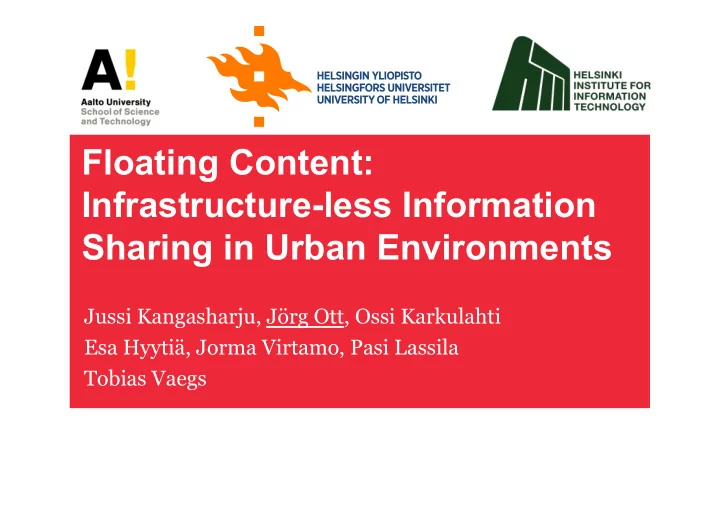

Floating Content: Infrastructure-less Information Sharing in Urban Environments Jussi Kangasharju, Jörg Ott, Ossi Karkulahti Esa Hyytiä, Jorma Virtamo, Pasi Lassila Tobias Vaegs
Infrastructure-less Content Sharing… • Ad-hoc local social network-style information sharing: Digital graffiti w/o servers and infrastructure • Leaves notes, comments, stories, etc. in places • Define reach (area of interest) and lifetime • Leverage delay-tolerant ad-hoc communication between mobile devices for information replication & acquisition
…in Urban Environments?! • Location privacy • Content “privacy” • Connectivity (to infrastructure) • Geographic validity • Temporal validity • User identification
Novelty? • Similar concepts have been “floating” around – At least as early as 2005 on floating – Geocasting and other approaches in late 90’s • Related work often limited in scope • Our contribution: – Thorough evaluation on feasibility – Figure out how to make this work in practice
Floating Content Example
Floating Model Anchor zone r a Buffer zone
Replication & Deletion Replication Deletion • ƒ(d) from anchor point • Only if buffer space needed • r, a for priority scheduling • ƒ(d) from anchor point • 1 within anchor zone • r, a as tie breakers • TTL-based deletion 1 1 0 0 r a r a
Content spread and prioritization
Two-Pronged Approach to Evaluation • Analytical modeling – Not covered in this talk – Different scenarios, different mobility models – Main result: Criticality condition • Simulations – Initially simple simulations to test feasibility – First result: Need 1 person per 50m 2 on average – This agrees with analytical criticality condition – In this talk: More detailed simulations
Some Simulation Findings • ONE Simulator: 4500 x 3400m simulation area – Helsinki City Scenario – Restless nodes (tourists) • Moving around along shortest paths between points of interest • On foot, by car • Some trams following regular routes – 126, 252, 504 nodes – 10m, 50m radio range – r = a = 200m, 500m
Unsuitably low density
Larger anchors
Closer to a “reliable” environment
Some Conclusions • Simple, yet appealing geo cooperation model • Workable already for modestly dense scenarios – Simulations agree well with theoretical modeling • Some built-in DoS protection and garbage collection • API and content sharing applications to come • Best effort model: user acceptance?
Present & Future Work • Theoretical foundations about criticality criteria – Paper under submission • More extensive simulation studies – Impact of location fuzziness – More diverse mobility models – Varied offered loads, resource sharing – Paper under submission • Implementation for Android in progress – Uses RFC 5050 message format as a basis • Plus TCP CL and node discovery drafts
Recommend
More recommend